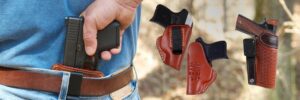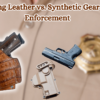How to Customize Your Leather Holster for Optimal Performance
When it comes to carrying your firearm, a leather holster stands as a classic choice, offering a blend of durability, aesthetics, and functionality. However, to achieve optimal performance, customization is key. Tailoring your leather holster to suit your specific needs can significantly enhance comfort, accessibility, and overall efficiency. This guide will walk you through the essential steps to customize your leather holster for the best performance.
Selecting the Right Fit and Style
 The foundation of a high-performing leather holster is its fit and style. Each firearm model requires a holster designed specifically for its dimensions. Ensure that your holster is snug yet provides enough space for quick drawing. When customizing, consider the carry position that suits your lifestyle—whether it’s appendix, strong-side, or cross-draw. The right carry position enhances accessibility and comfort. Additionally, consider the leather type. Full-grain leather offers unmatched durability and will conform to your firearm over time, while top-grain leather provides a balance between quality and cost. Personalize the style with color choices and embossing to reflect your preferences, ensuring both form and function.
The foundation of a high-performing leather holster is its fit and style. Each firearm model requires a holster designed specifically for its dimensions. Ensure that your holster is snug yet provides enough space for quick drawing. When customizing, consider the carry position that suits your lifestyle—whether it’s appendix, strong-side, or cross-draw. The right carry position enhances accessibility and comfort. Additionally, consider the leather type. Full-grain leather offers unmatched durability and will conform to your firearm over time, while top-grain leather provides a balance between quality and cost. Personalize the style with color choices and embossing to reflect your preferences, ensuring both form and function.
Adjusting Retention and Accessibility
Retention and accessibility are critical aspects of holster performance. Begin by assessing the retention level your holster provides. A well-customized holster should secure your firearm firmly while allowing for smooth drawing. Many leather holsters come with adjustable retention screws. Experiment with these adjustments to find the perfect balance. Too tight, and your draw speed decreases; too loose, and your firearm might not stay secure. For enhanced accessibility, consider customizing the cant angle—the tilt of the holster. A forward cant can aid in faster draws, particularly from concealed positions. Remember, the goal is a seamless draw that feels natural and intuitive.
Enhancing Comfort and Protection
 Comfort is paramount, especially for those who carry their firearm daily. The customization process should include measures to enhance the holster’s comfort without compromising on protection. Start by adding a soft lining or padding to the interior of the holster. This not only protects your firearm’s finish but also prevents discomfort during extended wear. Additionally, consider reinforcing key stress points on the holster to prevent wear and tear. Edges can be smoothed and sealed to prevent chafing. Lastly, regular conditioning with leather care products will maintain the holster’s pliability, ensuring it adapts to your body’s contours over time.
Comfort is paramount, especially for those who carry their firearm daily. The customization process should include measures to enhance the holster’s comfort without compromising on protection. Start by adding a soft lining or padding to the interior of the holster. This not only protects your firearm’s finish but also prevents discomfort during extended wear. Additionally, consider reinforcing key stress points on the holster to prevent wear and tear. Edges can be smoothed and sealed to prevent chafing. Lastly, regular conditioning with leather care products will maintain the holster’s pliability, ensuring it adapts to your body’s contours over time.
Customizing your leather holster is not merely about aesthetics; it’s about tailoring functionality to meet your precise needs. By focusing on fit, retention, accessibility, and comfort, you can transform a standard holster into a reliable partner for carrying your firearm safely and efficiently. Remember, the right customization can make all the difference in achieving optimal performance.












